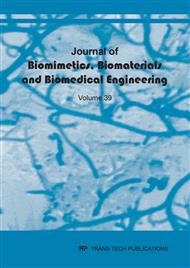[1]
Wasim M.K. Helal, Dong Yan Shi. Stress Distribution Surrounding Endodontic Prefabricated Parallel Post. Applied Mechanics and Materials. 2015, 752-753: 39-43.
DOI: 10.4028/www.scientific.net/amm.752-753.39
Google Scholar
[2]
Wasim M.K. Helal, Feng Chun Jiang, Dong Yan Shi, Diaa El Din Fouad, and Mohamed Osman. Determination of the Optimum Material for an Endodontic Prefabricated Post Using a Sub-Problem Approximation Method. Journal of Biomimetics, Biomaterials and Biomedical Engineering. 2018, 35: 50-66.
DOI: 10.4028/www.scientific.net/jbbbe.35.50
Google Scholar
[3]
Mohamed Zaazou, Mohamed El-Anwar, Mohamed El-Zawahry, Mohamed Abou Elnaga. The Effect of Post Materials on stress Distribution on Endodontically Treated Lower first premolar: Finite Element Analysis study. Australian Journal of Basic and Applied Sciences. 2012, 6(12):492-498.
Google Scholar
[4]
Wasim M.K. Helal, Dong Yan Shi. Optimum Material Gradient for a Functionally Graded Endodontic Prefabricated Post: FEA. Proceeding of The 2nd International Conference on Advanced Materials, Mechanics and Structural Engineering (AMMSE 2015), Je-ju Island, South Korea, September 18-20, (2015).
DOI: 10.1201/b19934-12
Google Scholar
[5]
Wasim M.K. Helal, Dong Yan Shi, Zhikai Wang. FE Analysis of the Effect of Material Gradient on the Performance of a Functionally Graded Endodontic Prefabricated Parallel Post. Applied Mechanics and Materials. 2015, 752-753: 382-386.
DOI: 10.4028/www.scientific.net/amm.752-753.382
Google Scholar
[6]
Wasim M.K. Helal, Dong Yan Shi. FE Analysis of Functionally Graded Material Plate During Debonding Case with Different Boundary Conditions. Key Engineering Materials. 2015, 627: 57-60.
DOI: 10.4028/www.scientific.net/kem.627.57
Google Scholar
[7]
Wasim M.K. Helal, Dong Yan Shi. Optimum Gradation Direction for a Functionally Graded Endodontic Prefabricated Parallel Post: A Finite Element Method. Journal of Biomimetics, Biomaterials and Biomedical Engineering. 2015, 24: 56-69.
DOI: 10.4028/www.scientific.net/jbbbe.24.56
Google Scholar
[8]
Wasim M.K. Helal, and D.Y. Shi. Optimum Material Gradient for Functionally Graded Rectangular Plate with the Finite Element Method. Indian Journal of Materials Science. 2014, 2014:7 P.
DOI: 10.1155/2014/501935
Google Scholar
[9]
Richard S. Schwartz, DDS, James W. Robbins, DDS, MA. Post Placement and Restoration of Endodontically Treated Teeth: A Literature Review. J of Endodontics. 2004, 30(5):289-301.
DOI: 10.1097/00004770-200405000-00001
Google Scholar
[10]
William C., D.M.D.. A review of the management of endodontically treated teeth. J.A.D.A.. 2005, 136:611-619.
Google Scholar
[11]
H. Alper TUKAY, Oğuz ERASLAN, Selçuk ORUÇ, Öznur ERASLAN. Effect of post material on stress distribution in endodontically treated teeth with wide root canal. SÜ Dişhek Fak Derg. 2009, 18:68-73.
Google Scholar
[12]
Özkan ADIGÜZEL, Senem YİĞİT ÖZER, Emrullah BAHŞİ, İzzet YAVUZ. Finite element analysis of endodontically treated tooth restored with different posts under thermal and mechanical loading. Int Dent Res. 2011, 3:75-80.
DOI: 10.5577/intdentres.2011.vol1.no3.1
Google Scholar
[13]
Wasim M.K. Helal, Dong Yan Shi. Stress Distribution Surrounding Endodontic Prefabricated Parallel Post. Applied Mechanics and Materials. 2015, 752-753: 39-43.
DOI: 10.4028/www.scientific.net/amm.752-753.39
Google Scholar
[14]
Coelho, C.S., Biffi, J.C., Silva, G.R., Abrahao, A., Campos, R. E. & Soares, C.J.. Finite element analysis of weakened roots restored with composite resin and posts. Dental Materials Journal. 2009, 28(6): 671-678.
DOI: 10.4012/dmj.28.671
Google Scholar
[15]
Sorrentino, R., Aversa, R., Ferro, V., Auriemma, T., Zarone, F., Ferrari, M. & Apicella, A.. Three-dimensional finite element analysis of strain and stress distributions in endodontically treated maxillary central incisors restored with different post, core and crown materials. Dental Materials: Official Publication of the Academy of Dental Materials. 2007, 23(8):983-993.
DOI: 10.1016/j.dental.2006.08.006
Google Scholar
[16]
Zarone, F., Sorrentino, R., Apicella, D., Valentino, B., Ferrari, M., Aversa, R. & Apicella, A.. Evaluation of the biomechanical behavior of maxillary central incisors restored by means of endocrowns compared to a natural tooth: a 3D static linear finite elements analysis. Dental Materials: Official Publication of the Academy of Dental Materials. 2006, 22(11):1035-1044.
DOI: 10.1016/j.dental.2005.11.034
Google Scholar
[17]
Wasim M.K. Helal, and Dongyan, Shi. Analysis of functionally graded rectangular plate by ANSYS. Key Engineering Materials. 2014, 572: 505-508.
DOI: 10.4028/www.scientific.net/kem.572.505
Google Scholar
[18]
F. Erdogan and Y. F. Chen. Interfacial cracking of FGM/metal bonds, in Ceramic Coating, K. Kokini, Ed. 1998, 29-37.
Google Scholar
[19]
Y. L. Chung and S. H. Chi. The residual stress of functionally graded materials. Journal of the Chinese Institute of Civil and Hydraulic Engineering. 2001, 13:1-9.
Google Scholar
[20]
ANSYS User's Manual, Version 12. 1.
Google Scholar
[21]
Joshi, S. Mukherjee, A. Kheur, M. & Mehta, A. 2001, Mechanical performance of endodontically treated teeth, Finite elements in analysis and design, 37(8): 587-601.
DOI: 10.1016/s0168-874x(00)00059-7
Google Scholar
[22]
Hong, S.Y, Lisa, A.L. Anthony, M. & David, A.F. 2001. The effects of dowel design and load direction on dowel-and-core restorations, Journal of Prosthetic Dentistry, 85: 558-567.
DOI: 10.1067/mpr.2001.115504
Google Scholar
[23]
T. Fuchiyama, N. Noda, T. Tsuji, and Y. Obata. Analysis of thermal stress and stress intensity factor of functionally gradient materials, in Ceramic Transactions: Functionally Gradient Materials, B. Holt, Ed., American Ceramic Society,Westerville, Ohio, USA. 1993, (34):425-432.
Google Scholar
[24]
T. Fuchiyama and N. Noda. Multiple crack growths in the functionally graded plate under thermal shock, in Proceedings of the 4th International Congress on Thermal Stresses, Osaka, Japan. June 2001:121-124.
DOI: 10.1080/014957301750379621
Google Scholar


